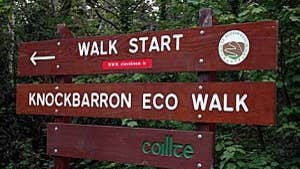The walk starts at the entrance to the wood where the car park is. There are ten stops on this trail, each clearly marked. This trail is a great example of an esker and, in the woods, it is almost completely undisturbed.
Along the way to the first marker, you will notice the many beech trees. Other trees that you will see along the trail are Oak, Ash, Scot’s Pine and Spruce. As you move along from here, you will notice the small areas of marsh, where the flora and fauna of these areas are especially diverse.
At the third stop is a place where the forest track cuts into the esker and it is possible to observe its composition. You can see the jumble of boulders, cobbles, gravel and course sand, all mixed up together, dumped by the turbulent meltwater in the ice tunnel in which the esker formed. Perhaps the best time to see the eskers is winter when they are less obscured by vegetation. There are other great examples of the esker at various points along the trail.
An interesting feature at stop seven is the wild clematis, the thick rope like stems that climb into the canopy of the trees. As you walk toward the eight stop in the woods, you can find remnants of the oak. Oak is one of the most important tree species for biodiversity support.
About KnockBarron Eco Walk
n the woods at Knockbarron one of the finest and most intact esker systems to be found anywhere in Ireland is preserved. This tells the fascinating story of how these landforms came to be at the very end of the last Ice Age.
This is also an area of old woodland with much of ecological interest at whatever time of year you visit. It is different at every season. Perhaps the best time for a first visit would be early May, when so much of the woodland floor is a blue haze of bluebells.
In mid-summer the woods settle into a few months of dark contemplation, except for the marsh, which is now drier and from which the newts that visit in spring to breed have mostly departed, but where that retiring and magic little fern-relative the adder’s-tongue, is beginning to show its tongues.
If you are interested in fungi, autumn is a great time to walk through Knockbarron: and if your main interest is geological heritage the best time is winter, when the eskers are less obscured by vegetation. At this time there is nowhere the informed imagination can more easily conjure up the boom of melting glaciers or the thunder of their meltwaters …
In other words, this is a place to visit time and again, at different times, in different ways. Each time the experience will be different.
Trail details
- Type:
- Walking Trail
- Location:
- Knockbarron Wood
- Grade:
- Moderate
- Format:
- Loop
- Length:
- 4.90km
- Ascent:
- 20m
- Dogs allowed:
- Yes
